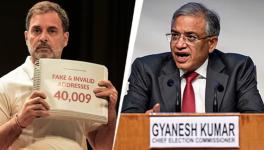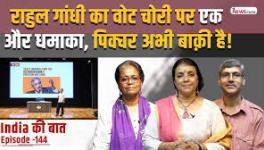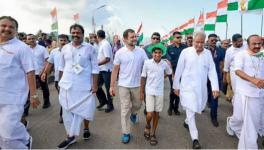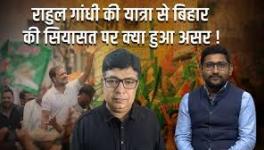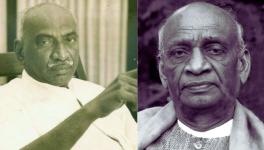Notes From the Field: Can Rahul Gandhi Achieve Bharat Jodo Target?
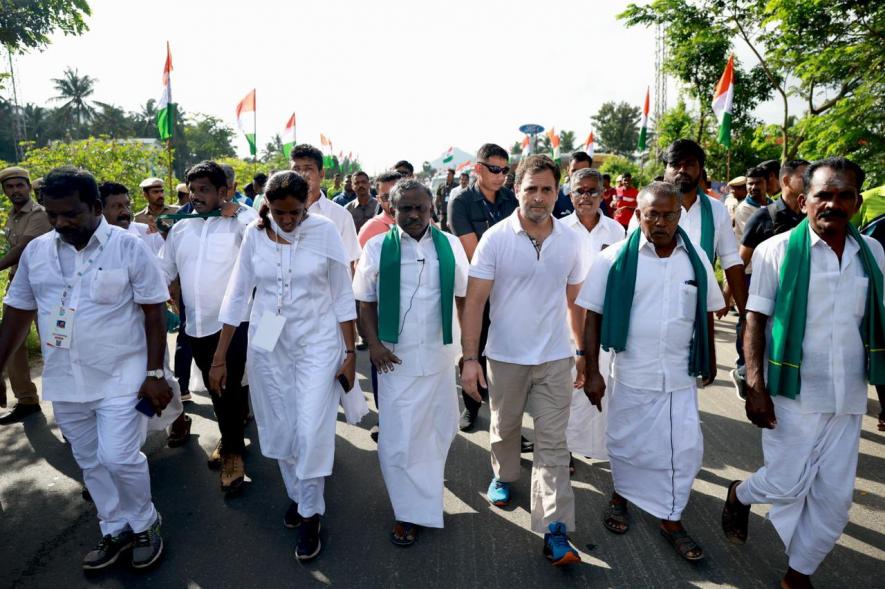
An over 12-hour drive from Chennai, in quaint Kanyakumari town of Tamil Nadu, an array of tricolour flags erected on all the roadsides greeted visitors. A day before the Congress party flagged off its Bharat Jodo Yatra, residents appeared considerably engaged with the event. Locally known as Inthiya Otrumai Payanam (it was scheduled for 7 September), the event had sunset point bustling with cars and vans.
Politicians, organisers and not a few civil society activists had descended on the town the evening before. I strolled around the walking area by the beach with friends, when a persuasive tea-coffee-seller served us off his bicycle. When he heard us speak Hindi, he got considerably excited. “I am from the Hindi heartland, but I can speak Tamil,” he told us. When asked why the town was buzzing, he responded, “Rahul ji is coming tomorrow and will walk to Kashmir.” When asked how he felt about it, he shared a story of having lost all his money and savings back home in Uttar Pradesh when his food stall failed during the COVID-19 pandemic. He said, “Rahul ji is walking for people like me, and I hope rising prices can be controlled, and employment opportunities are created”. “There will be a sea of people here tomorrow,” he predicted, quite correctly.
Starting the Yatra from Kanyakumari is a compelling antithesis to the usual lens of viewing India from the perspective of the so-called Hindi belt. Kanyakumari is also a Congress bastion, making it a conducive origin point for the Congress’ Yatra. It is a pitch to revive the party and spread its message among voters two years before the next general election, while the ruling Bharatiya Janata Party spreads its own message of nationalism and communalism. Herein lies the test for Rahul Gandhi, the Congress leader and its former chief.
The 7th was quite eventful, even setting Twitter abuzz with hashtags supporting and criticising the Congress initiative. Numerous journalists, and local, regional and Delhi-based media houses, reported on the developments, sought sound bytes, and so on.
The town had approximately 30,000 people pour in and out for the event. After visiting former prime minister and Rahul Gandhi’s father Rajiv Gandhi’s memorial in Sriperumbudur in the morning and securing the flag from Tamil Nadu Chief Minister MK Stalin at Gandhi Hall, Rahul emerged on stage by evening. His fellow wayfarers—the yatris—selected after an interview were with him. The event started with Tamizh Thaai Vaazhthu, Tamil Nadu’s anthem, followed by Vande Mataram and the Bharat Jodo Tamil anthem. The way the event was organised signified the nation’s founding ideas, with its diversity a definitive attribute.
In a passionate address, a tinge poignant, Rahul invoked fraternity, social justice, and harmony, citing the tricolour as a symbol of a value system—the idea of India—and saluting it without subscribing to its values was a farce. It was a call to forge an agonistic society and democracy that appreciates and respects differences within an inclusive contour of unity.
Unsurprisingly, a jibe at the media being muzzled by the BJP-led government garnered loud applause. As the event ended, Yogendra Yadav, who has joined the 3,750-km march, stressed how the Yatra is beyond political parties; a movement to hear people’s grievances and aspirations. Rahul and the yatris moved to their campsite where the shipping container-like vans they would stay in throughout the journey were stationed.
It was an early start on the first day of the Yatra, and numerous Congress leaders from across the country and many activists joined the first session of the march. A few leaders joined the march in their cars. Many party workers joined the rally to get close to their leader and perhaps secure a selfie with him. The party paid not much heed to these workers. The public was on the streets, too, as Rahul walked across town to Nagercoil. The Seva Dal seemed to have found its mojo. Seeing them do what they were conceived for was refreshing—actively mobilising people and orchestrating movements.
Between the two walking sessions of a day, Rahul is slated to meet civil society activists, who are being grouped by their area of work. The first breakout session had women’s rights, scheduled castes’ rights, and environmental activists meeting him at a school. The closed-door meetings keep even party workers out, barring very few organisers.
A few concerns are in order. The reliance on Yogendra Yadav to mobilise civil society and his teams’ say in matters related to the Yatra did not go down well among party workers. One can argue that such collaborations are vital for the success of movements. Yet, it is crucial to address party workers’ morale at this juncture. Proximity to the leader is a huge motivational factor that drives cadres.
True, the nature of a yatra is such that more significant issues and the general public take precedence over leaders and party workers. Yet, the organisers could have fixed a time slot to meet party workers. That would have gone a long way. Engaging interactions with the public and activists are commendable, but for it to pivot into meaningful politics, a party needs motivated cadres. Those in charge of tasks come across as territorial rather than collaborative. The cadres of one leader would often not work well with other leaders’ teams. The information does not pass freely between groups; hence, there are last-minute changes.
Indeed, these hiccups are par for the course in long-drawn-out initiatives, but communication can paper over last-minute glitches. Indeed, there is also a parallel centralised coordination system, and soon its effectiveness in circumventing hurdles as the journey progresses will be revealed.
For now, the late Paul Brass’ remarks from over a century ago echoed across the Yatra’s route map: the factionalism and asymmetry of information he spoke of were visible in the party’s events and the Yatra itself. That said, two veteran leaders, Digvijaya Singh and Jairam Ramesh, were at the helm of affairs, probably bridging the fault lines. Neither Mahatma Gandhi nor the British rules expected the Dandi March to turn out the way it did. So, concerns exist, but the Bharat Jodo came across a sincere attempt to revive the great Indian tradition of embracing difference and unity at once.
The author has an invitee pass to the event, and hence uses a pseudonym. He travelled with the yatra in his personal capacity. The views are personal.
Get the latest reports & analysis with people's perspective on Protests, movements & deep analytical videos, discussions of the current affairs in your Telegram app. Subscribe to NewsClick's Telegram channel & get Real-Time updates on stories, as they get published on our website.












